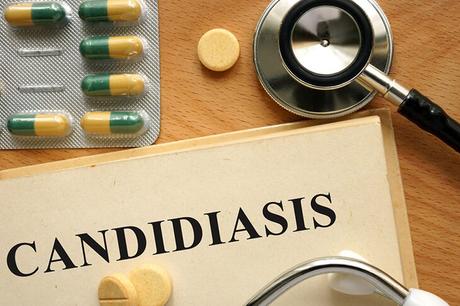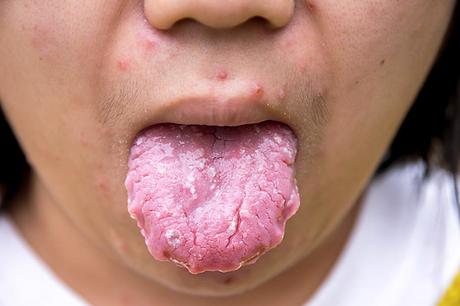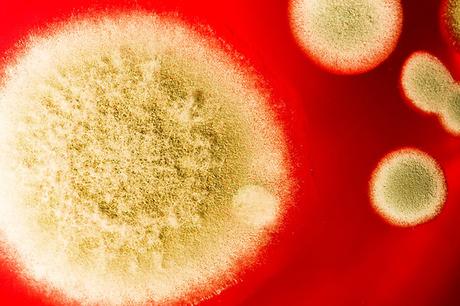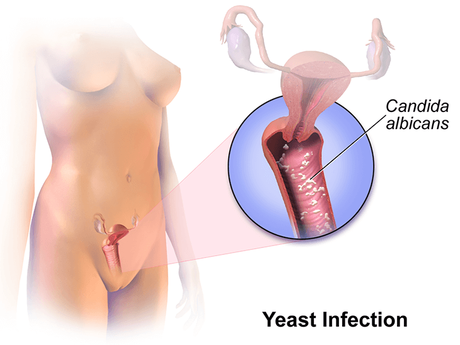What is a Yeast Infection?
A yeast infection is the development of Candida and it can occur in many different places on the body. When it occurs in the mouth, it is known as thrush. With this type, you will clearly see white spots on the tongue and possibly the throat as well as other parts of this area. If it occurs in the vaginal or groin area, it is known as a yeast infection and it can many different and uncomfortable effects such as a burning sensation, itchiness and possibly even a white, thick discharge that looks like cottage cheese. In men, it is also possible for the sexual organ to develop a yeast infection but this is very rare and not as common as it is for women to develop yeast infection.

There are many different types of yeast infections so you will need to know the answer to “What is a yeast infection?” before you try to find a remedy. The most common type is Candida Albicans. Anyone can get this type of infection, even children. Children can develop thrush, which occurs in the mouth at a very early age, even as young as one month old. Another age group that is more susceptible to this condition is the elderly who may have immune systems that are weak. In women, yeast infections are common in pregnancy if the woman does not have a strong and healthy immune system. If this condition occurs during pregnancy, additional effects may include a lower birth weight of the baby. Thrust or mouth yeast infections have occurred in many babies under the age of one month old and well. Also, patients who are being treated for AIDS as well as cancer are at a higher risk of getting yeast infections.
Another type of yeast infection is invasive candidiasis which is more serious than the other common types. This type of yeast infection can occur in a person’s heart, blood, bones, brain or any other area on a person’s body. The most common type is in the blood and this can happen when the Candida travels into the bloodstream and is responsible for an infection.
Symptoms of Yeast Infection
The symptoms of yeast infection will vary depending on the area that is affected. They can also vary if you are a man or a woman. Regardless of how minor the effects are, it must be treated to prevent further health complications.
Symptoms of Yeast Infection in Women
Even though burning and itching are both a common symptom of yeast infections, it doesn’t necessarily mean you have one since it may be a sign of vulvar dermatitis. Also, if you experience a vaginal discharge, this also does not mean you have a yeast infection. You may not need to buy over the counter treatments. These symptoms may be due to personal hygiene products such as soap and other sanitary products. Sometimes creams can cause this too. With mouth yeast infections, you will see patches of white on the tongue and possibly other parts of the mouth.

Symptoms of Yeast Infection in Men
Yes, men can get yeast infections too. Balanitis in men is a very common occurrence. It is characterized by inflammation in the groin area, mainly the penis. The foreskin swells up and you may also notice white bumps in this region. It may also be accompanied by reddening and also pain or discomfort on the foreskin. Just like women, men can also have a discharge with a pungent odor. Typically, this condition is more common amongst men who have not been circumcised or do not have a good personal hygiene regimen. Sometimes other factors such as viral or bacterial infections may cause this condition as well as personal hygiene products like soap.
Balanitis is typically found in uncircumcised men and is caused by poor hygiene. This inflammation may also be caused by a fungal, bacterial, or viral infection, using caustic soaps, or failing to sufficiently rinse soap off.
Diagnosis of a Yeast Infection
The diagnosis of a yeast infection of the mouth includes the scraping of the affected area to be tested. It is typically tested under a microscope. Your doctor may also request a culture but this is not a guaranteed method of determination for thrush or a mouth yeast infection.

Vaginal yeast infections are not easy to diagnosis because they are similar in nature to various other infections that can occur in the genital area. Usually, a doctor will get a sample from the vagina and view it using a microscope to check for high levels of Candida. It is difficult to determine an infection because Candida normally lives within the human body.
Invasive yeast infections are diagnosed through a blood test and the doctor may also do a culture. The blood samples are shipped to a laboratory testing service and it takes a few days to get the results back. If you are diagnosed with this type, treatment can be expensive and it may take a long period of time to get back to normal.
The Prevention of Yeast Infection
Normally, yeast infections are not a serious health condition. You can easily prevent them from happening in the future. Though they are not serious, they can be a nuisance because of the discomfort they can cause. There are some easy things you can do to for prevention of yeast infections.
- Good Personal Hygiene – Good hygiene is important for prevention of this illness. If the yeast infection is in the mouth, good oral hygiene can help stop it. For vaginal infections, it is important to keep the vaginal region clean so you feel fresh and stop yeast infection development. When you are showering or bathing, the vagina needs to be cleaned where yeast can thrive. Make sure you dry off well after bathing or showering.
- Clothes and Yeast Infections – What you wear can help prevent yeast infections. Wearing comfortable clothes that can absorb the moisture are best. Undergarments made of cotton or silk will both work well since the material can absorb moisture given off by your body helping to stay dry. Do not wear garments that are made of synthetic material such as nylon. These types of garments will not absorb moisture well and may cause a yeast infection.

After you come back from the gym, don’t leave the same sweaty clothes on. It’s best to change into clothes that are clean and dry to prevent a yeast infection. A good idea is to shower or take a bath before dressing into a fresh set of clothing. Don’t forget to dry off well. The same rules apply to bathing suits after going for a swim.
Frequently change your undergarments to protect yourself from yeast infections. This is an easy yeast infection prevention method.

Avoid wearing tights, leggings and also pantyhose. This increases the amount of heat in the crotch region and can cause excessive moisture. You need to stay as dry as possible to prevent yeast infections. If you have to wear these garments, use cotton underwear since cotton is very absorbent.
- Sleepwear Recommendations – Don’t wear clothes that fit tight or snugly. If you sleep in a pajama at night, switch to a comfortable cotton gown so your skin can breathe. You can also sleep not wearing underwear. Yes, this is strange but it will help avoid problems with yeast build up.
- Cosmetics – If you suffer from yeast infections especially in the mouth, it is best to avoid using cosmetics. The ingredients can aggravate the condition and sometimes even cause it, especially those with fragrances. If you need to use it, make sure there is no fragrance in it. It’s also a good idea to use hypoallergenic cosmetics.
Treatment of Yeast Infections
If you get a yeast infection, you have many options to choose from. There are over-the-counter treatments you can buy that don’t need a prescription or you can get a prescription treatment from your doctor. You can choose from creams that you can get without prescription and also oral medications. If you decide to use a nonprescription solution, use it only if you are not pregnant. Because this condition may not be easy to diagnose, be sure you have a yeast infection before you use a store-bought solution. If you have a sexually transmitted infection, you will need to see a medical professional first. Recurrent yeast infections also require medical attention and most likely, you’ll get a prescription treatment.

If you get a yeast infection when you are pregnant, it’s because of an increase in hormones. Even in this case, you may not have an infection just because you have the symptoms. If you’re not sure, do not use over-the-counter treatments and ask the doctor first.
Even though prescribed medicine works well, there may be side effects associated with it. Antifungal prescriptions work well such as Fuconazole. Some of the side effects include nausea and headaches as well as pain in the abdomen.
Yeast Infection in Men
Just like women, men can also get candidiasis, also known as yeast infection. It’s not as common in men as it is for women but both sexes are prone to it. Most men don’t know they have it since symptoms may be nonexistent so it is a silent illness. Typically, men get yeast infections in the mouth, groin, anus, gut and possibly on the skin amongst other areas. The causes of yeast infection are many but the most common reason why it happens is a reaction to antibiotics. If a male is prescribed an antibiotic to eliminate an infection, a yeast infection may possibly develop and cause an over-abundance of bacteria. The antibiotic may eliminate the bacteria that is good resulting in a harmful effect.

Another common cause of yeast infections in men is a weak immune system. This occur when you don’t have a healthy lifestyle such as not eating healthy foods, other infections, etc. When it comes to diet, there are foods that can cause an over-growth of yeast. It is because of foods that are high in refined sugar. Beer can also promote an increase of yeast bacteria leading to an infection. Diabetic men are more prone to this disorder, more so than men who not have diabetes.
If you’re a male that has a yeast infection, you can find over the counter treatments such as lotions to treat it. Many of the creams that are available can be used by both men and women and can also be used on the penis to treat the condition. For a first time yeast infection in men, you may be given a prescription of Diflucan by your doctor. If the infection doesn’t clear up with the standard treatments, you may need to use an antifungal treatment up to two weeks. Another option is boric acid capsules. You can also try probiotics such as in yogurt.
You can prevent a yeast infection from developing and the tips are the same as for women. Additional tips that are just for men include using protection that will stop you from getting it and also stop you from transmitting a yeast infection to your partner. Also, find ways to increase oxygen flow to the groin since this will also help prevent this condition from developing.
Vaginal Yeast Infections
This condition occurs when there is an excessive growth of the normal yeast bacteria in the vagina. An excessive amount of yeast does not mean you have a serious health problem, but you need to treat it to get rid of it. Having it is a normal part of a woman’s life and health. Yes, it can be a hindrance for a woman because of the symptoms associated with Candidiasis. If you have it, you need to have a balance of these bacteria as well as other bacteria that is found within a woman’s body. A yeast infection can occur anywhere on the body but the most common area is the vagina in a woman. If it’s not treated, it can be transmitted sexually and it may cause other issues, so don’t wait to do something about it.

This condition is called Candida Albicans and occurs in areas that are rich is moisture. The area of the body that are high in moisture are more susceptible. Vaginal yeast infections fall into this category. If you suffer from this condition, you must speak to or visit the gynecologist to determine the best treated and determine if you really have this type of infection or not. If it’s on the skin, you may be able to treat it with over the counter solutions. If the infection is within the vagina, it must be treated by a gynecologist and a prescription solution. Most women will have a vaginal yeast infection in her life at least once but some are more prone than others.
The typical symptoms of this disorder include the appearance of redness, itchiness and possibly burning. You may also see an irritation on the skin and the condition may also affect the health of the vulva. Other symptoms may also include urinating frequently and feeling pain in the vagina. When you see a thick and white discharge, you must see a doctor to be treated. It’s not a serious problem but don’t let it slide. You may experience other gynecological problems later on if the current condition remains without treatment.
Read more about Home Remedies for Vaginal Yeast Infections at : https://ambrossimo.com/vaginal-yeast-infections-treatments/
Pregnancy Yeast Infections
The common time that women get yeast infections is during pregnancy. This may happen in the second trimester and there may be an increase in discharge that has a strange odor. Speak to your pregnancy-attending doctor and find out which treat are best and safe for you during your pregnancy. In this case, anti-fungal medications are not recommended.
Yeast infections during pregnancy are caused by hormonal changes or by taking hormones. It is also common for women on birth control to develop a vaginal yeast infection or other types of this illness. This condition may also be common during pregnancy because the conditions in the vagina change. You may have more sugar that helps the yeast thrive. It causes an imbalance leading to fungus developing.
Pregnancy yeast infection can be treated using suppositories and/or creams that are recommended by your doctor. Oral medications are avoided because they may not be safe for the woman or her child. You need be treated for the condition so your unborn child does not get an oral yeast infection at the time of delivery. Even though there are treatments, it does not mean the infection will go away quickly. It may take as long as 2 weeks to clear. Once it has cleared, you will need to take preventative measures.
Now that you have basic background information, you’ll be able to select the best treatment or get one from the doctor to ensure it goes away. Then it’s preventative maintenance to keep the yeast infection away permanently.
